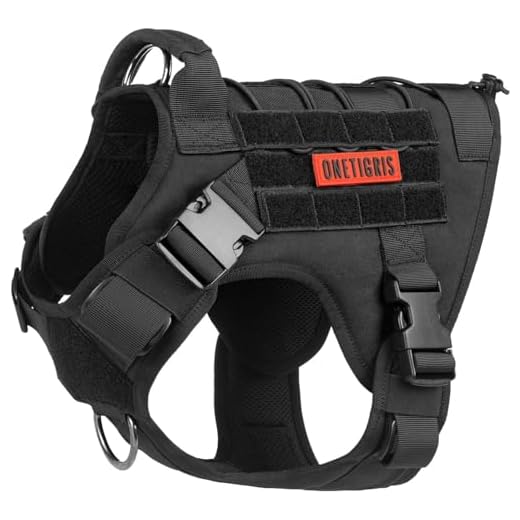




First things first: ensure the loop is positioned correctly around your furry friend’s body. This setup should rest comfortably behind the front legs, avoiding any stress on the neck. Adjust the length of the loop so that it sits snugly but does not restrict movement. Comfort is key here, allowing your pet to enjoy their walks without any discomfort.
Next, fasten the end of the strap to the designated clip on the harness or collar. A secure connection is crucial, as it prevents any unexpected slips during your outing. Pull gently on the strap after securing it to double-check that everything is locked in place. This simple check can save you from potential mishaps and ensures a safe experience for both of you.
As you prepare to head out, take a moment to observe your pet’s behaviour. Some dogs may need a little time to adjust to the new setup. If your companion seems uneasy, give them a moment to acclimatise before starting your adventure. Remember, the goal is to make those walks enjoyable, not stressful.
Choosing the Right Figure of Eight Lead for Your Canine
Selecting the appropriate harness for your furry companion is crucial. The right option ensures comfort and control. Here are key factors to consider:
Material Quality
- Opt for durable fabrics like nylon or cotton that can withstand wear and tear.
- Look for leads with padded sections to prevent chafing.
- Consider waterproof materials if your pet loves water activities.
Size and Fit
- Measure your pet’s neck and chest circumference to ensure a snug fit.
- Check for adjustable features to accommodate growth or seasonal changes in fur.
- Choose a design that allows for easy on and off, especially for excitable pups.
Pay attention to the width of the straps; wider options distribute pressure better, reducing strain on your pet’s neck. If your canine is a strong puller, consider a lead with a front-clip option to discourage pulling.
Finally, don’t forget to test the fit before purchasing. Take your furry friend for a short walk and observe how they move. A well-fitted harness should allow for free movement without causing discomfort. Happy walking!
Preparing Your Canine for Harness Application
Start with a calm environment. Choose a quiet space free from distractions, allowing your companion to feel relaxed. It’s important to approach this process with patience; some pets may initially resist, so gentle handling is key.
Begin by letting your furry friend sniff the harness. This familiarisation can ease any anxiety. Offer treats or praise during this stage to create positive associations. Gradually place the harness on their back without fastening it at first, allowing them to get used to the sensation. Observe their behaviour; if they seem uneasy, take a step back and try again later.
Next, practice the fitting without securing it. This helps your pet understand that it’s a normal part of their routine. After a few repetitions, try fastening it briefly. Monitor their comfort levels closely. If they show signs of distress, remove the harness immediately. Always take it slow–confidence builds through positive experiences.
Once your companion seems comfortable, you can introduce the lead. This can be a fun moment for both of you. Let them explore the lead while it’s attached to the harness, rewarding them for calm behaviour. Consistency is key; repeating this process helps reinforce the experience.
If you’re interested in furthering your understanding of animal behaviour, check out how to become a dog behaviour training specialist. It offers valuable insights into ensuring a happy and healthy relationship with your pet.
Correctly positioning the lead on your pet’s head
Position the harness snugly around the muzzle, ensuring it sits comfortably without pinching or causing irritation. The loop should rest just below the eyes, allowing for natural movement and visibility. Adjust the straps so that they fit securely but are not restrictive; you should be able to fit two fingers between the harness and your pet’s skin.
Next, secure the back strap behind the ears, ensuring it lies flat against the head. This strap should not interfere with your pet’s hearing or movement. If your companion seems uncomfortable, readjust until it feels right. Observing their body language is key; signs of distress indicate a need for modification.
Once everything is in place, take a moment to reward your furry friend with a treat or praise. This positive reinforcement associates the fitting process with a pleasant experience, making future outings more enjoyable. Always check the placement before each walk, as adjustments may be necessary over time due to changes in fur length or behaviour.
Adjusting the Lead for Comfort and Security
Ensure the harness fits snugly but not too tightly. You should be able to slide two fingers comfortably between the material and your pet’s skin. This prevents chafing and allows for freedom of movement without compromising control. If the fit seems off, make small adjustments to the straps until it feels just right.
Checking for Proper Fit
After adjusting, observe your pup’s behaviour. If they seem restless or try to shake off the harness, it might be too loose. Conversely, if they appear uncomfortable or are hesitant to walk, it could be too tight. Take a moment to let them acclimatise to the new setup before heading out.
Monitoring During Walks
While strolling, keep an eye on how your pet interacts with the lead. If they pull or lunge, reassess the tension. A lead that’s too tight can cause anxiety, while one that’s too loose may lead to escape attempts. Adjust as needed to find a balance that keeps both of you comfortable and secure throughout your outings.
Practicing the lead walking technique with your canine companion
Start with short sessions in a quiet area. This helps to minimise distractions and allows your furry friend to focus on you. Use treats to reward good behaviour. When your pet walks beside you calmly, offer a treat and praise. This reinforces the desired behaviour and encourages them to stay close.
Use a clear command, like “Heel,” to signal your pet to walk beside you. Consistency is key, so always use the same word. Initially, you might walk at a slow pace. As your pet becomes accustomed to the command, gradually increase your speed. This helps them learn to keep pace with you.
Occasionally change directions during your walk. This keeps things interesting for your companion and encourages them to pay attention to your movements. If they start pulling ahead, gently guide them back to your side using the lead. Avoid yanking or harsh corrections; instead, use a firm but gentle hand.
Incorporate various environments into your practice. Walking in different settings, such as parks or busy streets, exposes your pet to new sights and sounds. This helps them to remain focused even in busier situations. Always reward them when they respond well to distractions.
Lastly, be patient. Mastering this skill takes time. Celebrate small victories and maintain a positive attitude. Your enthusiasm will reflect on your furry friend, making them more eager to learn and walk beside you.
FAQ:
What is a figure of eight dog lead and how does it work?
A figure of eight dog lead is a type of training lead designed to give more control over a dog during walks. It’s made of a long piece of strong material that forms a figure of eight shape when placed on the dog. The lead goes around the dog’s muzzle and behind its ears, allowing the handler to guide the dog gently without causing discomfort. This design helps in managing pulling and encourages the dog to focus on the handler.
How can I put a figure of eight lead on my dog correctly?
To put a figure of eight lead on your dog, first ensure your dog is calm and comfortable. Hold the lead so that the loop meant for the muzzle is at the top. Gently place the loop over the dog’s nose, ensuring it sits comfortably without pinching. Then, take the other end of the lead and bring it behind the dog’s ears, securing it under the chin. Adjust it so it fits snugly but not too tight, allowing your dog to breathe easily. Make sure to reward your dog with praise or treats to create a positive association with the lead.
What should I do if my dog resists wearing the figure of eight lead?
If your dog resists wearing the figure of eight lead, take it slow. Start by allowing your dog to sniff and explore the lead before attempting to put it on. You can practice putting it on for short periods, gradually increasing the time as your dog becomes more comfortable. Always use positive reinforcement, such as treats or praise, when your dog accepts the lead. If your dog continues to show resistance, consider consulting a professional dog trainer for tailored advice.
Are there any safety tips I should be aware of when using a figure of eight dog lead?
Yes, there are several safety tips to consider when using a figure of eight dog lead. Ensure the lead is the correct size for your dog to prevent slipping or choking. Always supervise your dog while they are wearing the lead, especially if they are not used to it. If your dog shows signs of distress or discomfort, remove the lead immediately. Additionally, be cautious in crowded areas where sudden movements could startle your dog or others.
Can I use a figure of eight lead for training my dog?
Absolutely, a figure of eight lead can be an effective tool for training your dog. It helps to establish better communication and control, particularly for dogs that may pull on walks. Using this lead, you can teach commands and reinforce good behaviour, such as walking calmly beside you. However, it’s important to combine the lead with positive training methods and consistency for the best results.
How do I properly put on a figure of eight dog lead?
To put on a figure of eight dog lead, first, hold the lead with the loop end facing up. Place the larger loop over your dog’s nose and slide it down to just behind the ears. The smaller loop should then be positioned around your dog’s neck. Adjust the lead to ensure it sits securely but comfortably, allowing for some movement without being too tight. Make sure the lead is not twisted and that your dog can breathe easily. Double-check the fit before you start walking your dog to ensure safety.
What should I do if my dog resists wearing the figure of eight lead?
If your dog is resistant to wearing a figure of eight lead, it’s important to introduce it gradually. Start by letting your dog sniff and explore the lead while it’s not being worn. Once your dog seems comfortable, try putting it on for short periods while rewarding them with treats and praise. This positive reinforcement can help them associate the lead with good experiences. If your dog continues to resist, consult with a professional dog trainer for additional techniques to help your dog adjust to the lead.










